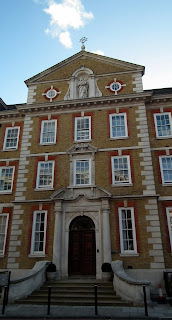
 One would expect the figures over the entrance of the Hospital of St John and St Elizabeth to be, well, John (the Baptist) and his mother Elizabeth.
One would expect the figures over the entrance of the Hospital of St John and St Elizabeth to be, well, John (the Baptist) and his mother Elizabeth.But Elizabeth was so old she had despaired of ever having a child, and this mother is young. Her baby raises his right hand up in blessing and in his left holds an orb, a symbol of kingly power usually reserved for Jesus.
So they must be the Madonna and Child.
This wing of the hospital was designed by Edward Goldie in 1902 as an extension to the main 1898 building, also designed by Goldie. The chapel front has a Maltese cross, a symbol of the Knights Hospitaller whose successor order runs the hospital today, and also of St John the Baptist.






